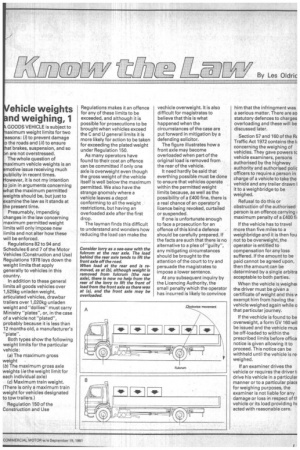ehicle weights nd weighing, 1
Page 33

If you've noticed an error in this article please click here to report it so we can fix it.
GOODS VEHICLE is subject to aximum weight limits for two easons: (i) to prevent damage o the roads and (II) to ensure hat brakes, suspension, and so n are not overstressed.
The whole question of aximum vehicle weights is an motive issue receiving much ublicity in recent times. owever, it is not my intention o join in arguments concerning hat the maximum permitted eights should be, but just to xamine the law as it stands at he present time.
Presumably, impending changes in the law concerning maximum permitted weight limits will only impose new limits and not alter how these will be enforced.
Regulations 82 to 94 and Schedules 6 and 7 of the Motor Vehicles (Construction and Use) Regulations 1978 lays down the weight limits that apply generally to vehicles in this country.
In addition to these general limits all goods vehicles over 1,525kg unladen weight, articulated vehicles, drawbar trailers over 1,020kg unladen weight and "dollies" must carry Ministry "plates", or, in the case of a vehicle not "plated", probably because it is less than 12 months old, a manufacturer's "plate".
Both types show the following weight limits for the particular vehicle: (a) The maximum gross weight (b) The maximum gross axle weights (ie the weight limit for each individual axle) (c) Maximum train weight. (There is only a maximum train weight for vehicles designated to tow trailers.) Regulation 150 of the Construction and Use Regulations makes it an offence for any of these limits to be exceeded, and although it is possible for prosecutions to be brought when vehicles exceed the C and U general limits it is more likely for action to be taken for exceeding the plated weight under Regulation 150.
As many operators have found to their cost an offence can be committed if only one axle is overweight even though the gross weight of the vehicle itself is well below the maximum permitted. We also have the strange anomaly where a vehicle leaves a depot conforming to all the weight restrictions, but having an overloaded axle after the first drop.
The layman finds this difficult to understand and wonders how reducing the load can make the vechicle overweight. It is also difficult for magistrates to believe that this is what happened when the circumstances of the case are put forward in mitigation by a defending solicitor.
The figure illustrates how a front axle may become overloaded when part of the original load is removed from the rear of the vehicle.
It need hardly be said that everthing possible must be done to ensure that vehicles operate within the permitted weight limits because, as well as the possibility of a £400 fine, there is a real chance of an operator's licence being revoked, curtailed or suspended.
If one is unfortunate enough to face a prosecution for an offence of this kind a defence should be carefully prepared. If the facts are such that there is no alternative to a plea of "guilty", any mitigating circumstances should be brought to the attention of the court to try and persuade the magistrates to impose a lower sentence.
At any subsequent inquiry by the Licencing Authority, the small penalty which the operator has incurred is likely to convince him that the infringment was a serious matter. There are so statutory defences to charges overloading and these will be discussed later.
Section 57 and 160 of the RE Traffic Act 1972 contains the li concerning the weighing of vehicles. They gave powers tc vehicle examiners, persons authorised by the highway authority and authorised polic officers to require a person in charge of a vehicle to take the vehicle and any trailer drawn I it to a weighbridge to be weighed.
Refusal to do this or obstruction of the authorised person is an offence carrying i maximum penalty of a £400 fii If the vehicle has to travel more than five miles to a weighbridge and it is then fou not to be overweight, the operator is entitled to compensation for any loss suffered. If the amount to be paid cannot be agreed upon, then the amount can be determined by a single arbitra acceptable to both parties.
When the vehicle is weigher the driver must be given a certificate of weight and this vi exempt him from having the vehicle weighed again while o that particular journey.
If the vechicle is found to be overweight, a form GV 160 wil be issued and the vehicle mus be off-loaded to within the prescribed limits before offica notice is given allowing it to proceed. This notice can be withheld until the vehicle is re. weighed.
If an examiner drives the vehicle or requires the driver t, drive his vehicle in a particular manner or to a particular placE for weighing purposes, the examiner is not liable for any damage or loss in respect of th vehicle or its load providing lit acted with reasonable care.








































































